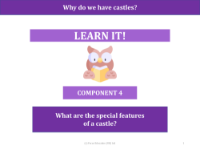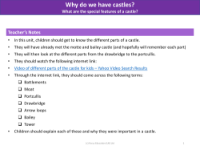What is it for? - Parts of a castle

History Resource Description
Castles are historical fortifications that served as both residences and strongholds. They were designed with various defensive features to protect inhabitants from invaders. Battlements, typically found at the top of castle walls, provided a defensive advantage, allowing soldiers to hide and shoot during battle while offering some protection. The barbican was an additional outer fortification, often a gateway or outwork, designed to defend the main entrance. Towers were integral parts of a castle's defensive strategy, providing a high vantage point for surveillance and defense. The portcullis, a heavy gridded gate, was often found at the castle entrance and could be quickly dropped to prevent entry during an attack.
Other key defensive features included the moat, a water-filled ditch surrounding the castle, acting as a first line of defense to hinder attackers and make tunneling beneath walls more difficult. The drawbridge served as a movable bridge over the moat, which could be raised or lowered to control access to the castle. Arrow loops were narrow vertical slits in the walls through which archers could shoot while remaining protected. The bailey was the courtyard enclosed by a defensive wall, where the castle's inhabitants could live and work in safety. Castles were not only military structures but also symbols of power and control, often housing important local government and administration within their walls.



